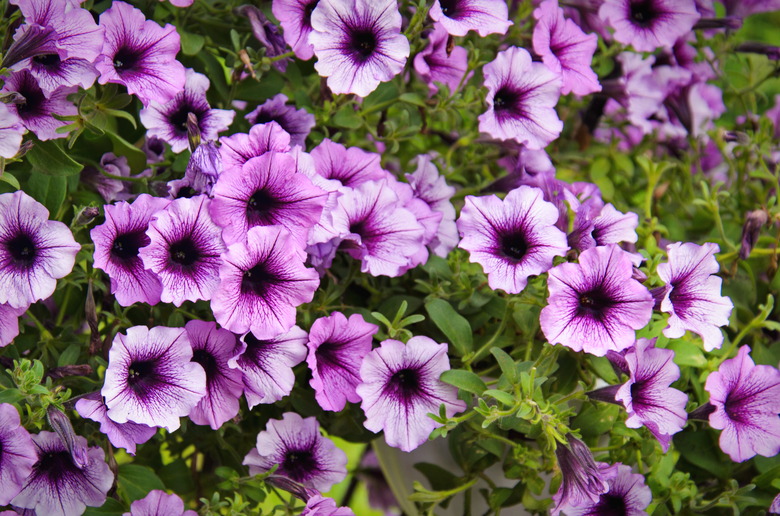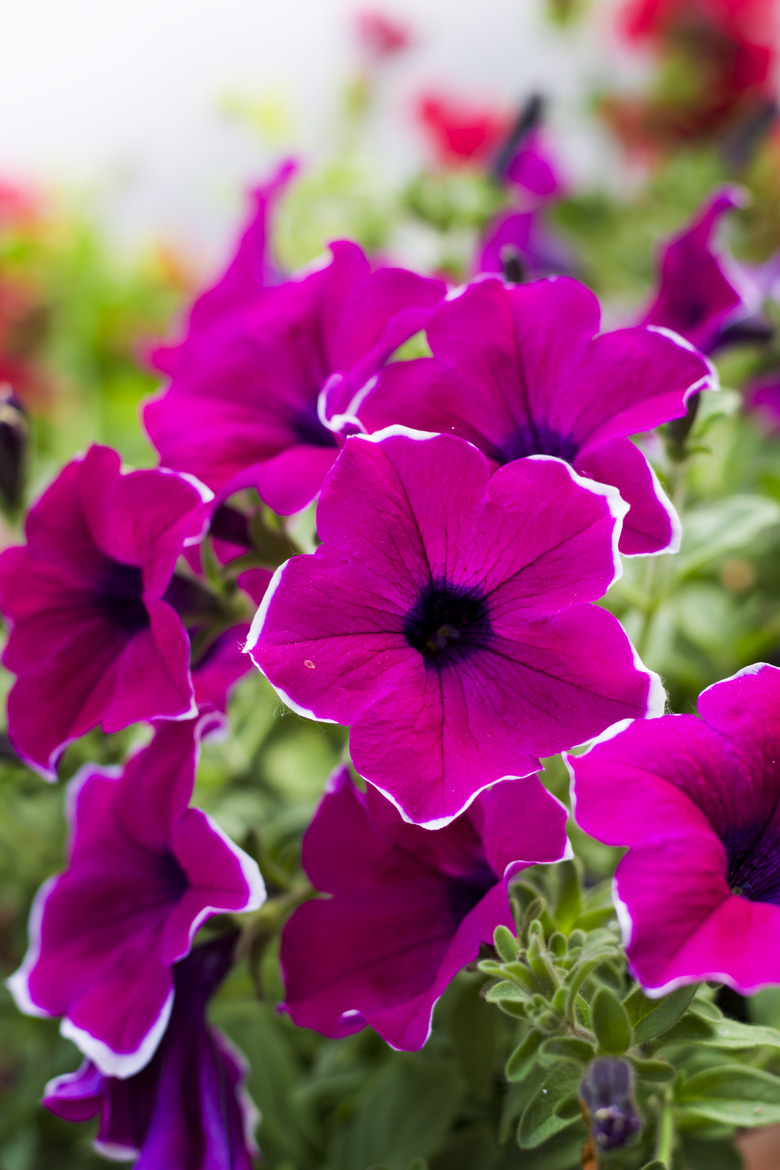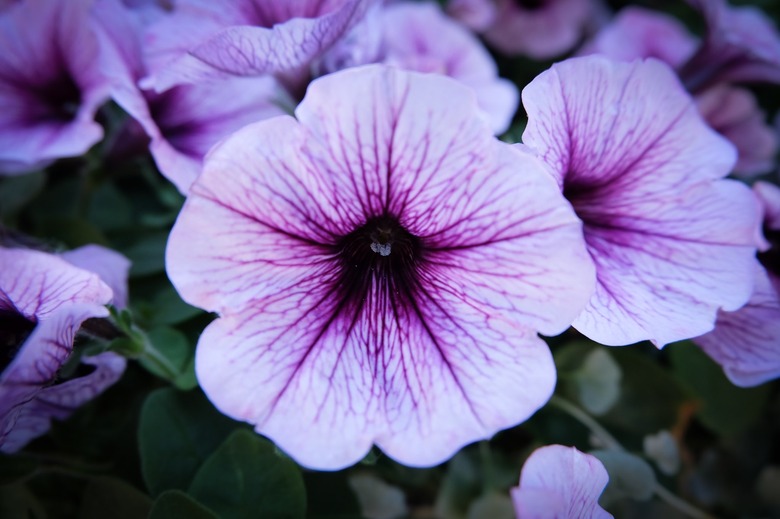How To Grow Petunias
We may receive a commission on purchases made from links.
Petunias (Petunia spp.) are extremely popular garden ornamentals native to South America. They produce trumpet-shaped flowers that bloom in spring, summer and fall, with foliage that is hairy and a little sticky. Their flowers also light up gardens in the American South in winter. Easy to grow and maintain, petunias grow fast and come in a wild riot of shapes and colors. They are perennials in warm zones but are grown as annuals in most areas.
Best Uses for Petunias
Best Uses for
Petunias
Petunias are admired for their pretty flowers, and the plants are best used to make your backyard or flower boxes beautiful. The blossoms offer a pop of color in garden beds but also in containers, on lawns and in borders, blooming and reblooming through the growing season. They can also serve as a vivid seasonal ground cover, particularly the spreading types, such as plants in the Wave® series. They are delightfully easy to grow and quite easy to maintain.
Petunias are available in many colors, including shades of red, purple, yellow, orange and white. Some blossoms are one solid color but not all. Some offer veins or edges in contrasting hues, and some varieties even have blossoms with star patterns. Flowers can be single, double or ruffled and come in a range of sizes. Some types of petunias have a lovely scent.
Petunias are both annual and perennial. Easy-grow petunia flowers can thrive almost anywhere in the country as annuals. Those in United States Department of Agriculture plant hardiness zones 9 through 11 can grow them as tender perennials. The flowers have a very long season and often bloom from spring until first frost.
They also come in a variety of sizes. Multiflora petunias are the toughest and the most prolific, with vast amounts of smaller flowers. Grandiflora flowers are huge (up to 6 inches across) and are best for containers since they damage easily in rain. Millifloras have flowers about 1 inch wide, but they have lots of them. Trailing petunias are great for ground cover or window boxes.
How to Grow Petunias
How to Grow
Petunias
Starting Petunias From Seed
Starting
Petunias From Seed
Petunia seeds are as small as dust, and most people go with seedlings. If you want to start petunias from seeds, sow the seeds indoors 10 weeks before the last spring frost. The seeds need constantly moist soil and lots of sunlight to germinate. When a seedling has three leaves, it is ready to be transplanted.
Starting Petunias From Seedlings
Starting
Petunias From Seedlings
Most people grow petunias from plant starts purchased from the nursery or garden store. These are young plants sold in six-packs or sometimes in larger flats. If you decide to go this route, select plants that are short, compact and not yet flowering. These will establish first and fastest. If there are flowers on the plants you select, pinch them off before planting.
Before you begin, work the soil well, mixing in a balanced fertilizer such as 8-8-8, 10-10-10 or 12-12-12 at a rate of 2 pounds per 100 square feet. For hanging baskets or window boxes, work time-release fertilizer into the potting mix according to the label directions for rate.
Space plants about 12 inches apart, setting each little transplant into the ground so that it sits at the same depth that it did in the container. If you are planting the petunias as ground cover, space them 18 to 24 inches apart. Ideally, the planting site should be sheltered from exposure to strong winds. Keep the soil moist until the little plants are established.
In What Zone Do Petunias Grow Best?
In What Zone Do
Petunias Grow Best?
Petunias are tender perennials in USDA plant hardiness zones 9 through 11, but they are usually grown as annuals, so most people in the country are able to plant them. In Florida and other hot regions, they are grown as winter annuals.
When Should You Plant Petunias?
When Should You Plant
Petunias?
Most people grow petunias as summer annuals. If that is your intention, plant the petunia starts in the spring after the last frost and watch them grow and flower until the first frost in fall or winter.
That's not the only possible planting date. These flowers are incredibly popular as winter annuals in the Sunshine State. For that use, they are best planted in October and November.
Soil, Sunlight and Water Recommendations for Petunias
Soil, Sunlight and Water Recommendations for Petunias
Petunias require well-draining soil, but aside from that, they aren't terribly picky. They don't necessarily need rich soil, but they do like it to be moist. That means improving it with organic content is a good idea since the amended soil will better hold water. However, any well-draining soil will do. For petunias planted in containers, it is another story. You should use a soil-free potting mix.
Petunias require sun to thrive. They can make do with five hours a day of direct sun, but all-day direct sun is even better. Pick the sunniest part of your garden and put the petunias there. The more shade, the fewer flowers you will enjoy.
These plants also need regular water. Don't give them shallow drinks, though. Help the petunias develop longer roots by watering deeply once a week or so. Even after they are established, a thorough irrigation once a week should be plenty in all but the hottest, driest weather. The water should soak the soil to at least 6 inches and maybe to 8 inches every time you water.
When it comes to petunias planted in containers, you'll likely need to water more often. This is also true when you are planting spreading petunias for ground cover or planting in hanging baskets. Water twice a week or even more if the weather is very hot.
Common Pests and Other Problems for Petunias
Common Pests and Other Problems for Petunias
Leggy petunia plants are not attractive, but you should expect them by midsummer. Like with most annuals, petunia stems grow taller after planting in spring. By July, they will start looking leggy. The simple solution is to sterilize a garden pruner and take off the top half of each stem. You can also pinch-prune leggy plants using your fingers. The lower half will look ragged for a few days, but with water and fertilizer, it will soon start producing flowers.
Rotting plants are almost always the result of soil that isn't draining well. Either move the petunias from the site or solve the drainage issue. Amending clay soil with compost or other organic matter is a great solution, but it is best accomplished before installing flowers.
Lack of blossoms is an issue that might surprise you with these ever-flowering plants. If you are seeing sparse flowering as time passes, your plant may be getting too much shade, or it may need fertilizer. If it's a shade issue, you'll need to move the plants. If it is a matter of nutrition, start fertilizing your petunias with a balanced fertilizer every month to keep them growing fast and blooming well. If you planted double-flowered cultivars, fertilize twice a month.
Seed pods are a part of the petunia plant's life cycle. Every plant does what it takes to reproduce in nature, but if you see seed pods on your plants, it's time to deadhead and prune. A plant that is producing seed pods is shutting down flower production as it sends its energy into reproduction. Use garden scissors to snip off the pods and deadhead wilting flowers while you are at it. Deadheading flowers regularly keeps the plants looking nice and is especially important for larger-blossomed species. Removing spent flowers also contributes strongly to extending the petunia's blooming cycle, possibly by weeks or more. Snip off not only the dying flower but the swelling below it as well. Some of the species with smaller flowers are self-cleaning, dropping their blossoms as they die.
Aphids are not bugs about which you will have nightmares. They are so small that if you only have a handful, you aren't likely to see them at all. Aphids get their meals by piercing the petunia foliage with their mouthpieces and then sucking out the plant's juices. They are not specific to petunias and will do this with many different plants. They congregate on the underside of leaves, and if your plants are infested, the aphids almost look like they are paving the bottom of the leaves. Try rinsing them off with a powerful hose.
Leaf miners are a type of worm-like bug that can pose a problem in the garden. Look for squiggly lines mined into the leaves. The larvae or maggots dwell in the leaves, creating the mines as they are eating. They don't have a preference for petunia leaves and will dig inside any garden leaf that has the bad luck to be in the neighborhood. Spray the affected plant parts liberally with neem oil to get rid of the leaf miners without doing any other damage to the garden.
Slugs damage petunias by eating holes in the leaves or taking bites around the edges, leaving them ragged. Like snails, they leave a track of silvery slime behind them. Pick the slugs off by hand and dispose of them or else build a beer trap with a shallow bowl of beer placed near the petunias. The slugs are attracted to it, and they crawl in and drown.
Budworm caterpillars are small and green. If they appear in your garden, they usually do so in late June or early July. They arrive as tiny larvae of a moth species, and they eat their way into flower buds and then consume the flower from the inside. Over time, they grow to several inches long. Watch your buds carefully and remove and destroy the ones showing the tiny holes.
Common Diseases for Petunias
Common Diseases for Petunias
Petal blight can be a serious problem when the weather is humid and rainy. This is caused by the blight fungus Botrytis that attacks landscape plants, including petunias. You won't see this issue unless parts of the plant stay wet for long periods of time, like in cool, wet, overcast or humid weather, but spraying the plants with water can also do it. The first symptom you'll see is small tan spots followed by a distinctive fluffy gray mold on blighted plant parts.
Botrytis in petunias will rapidly blight the flowers. To fight this issue, keep the plants as dry as possible. Never get irrigation water on the foliage and be sure to space plants far enough apart to allow prompt air drying of leaves.


